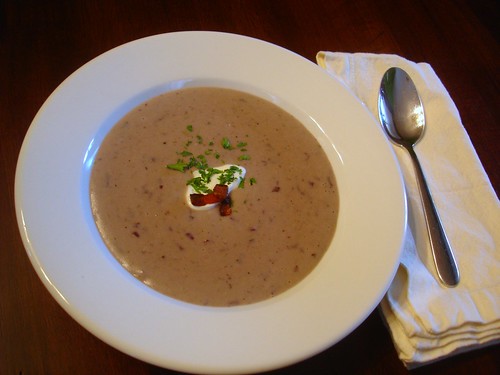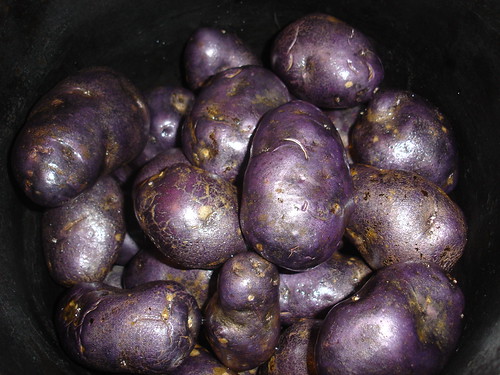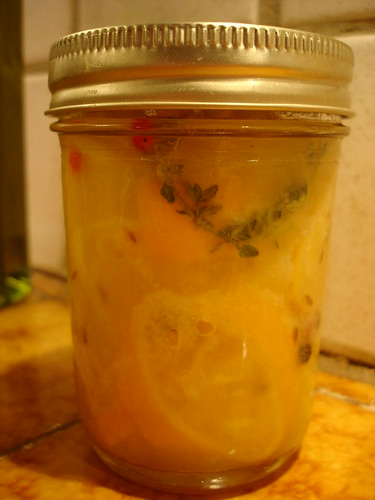Purple potatoes, originally uploaded by chrisfreeland2002.
2008 is the International Year of the Potato (yes, really) and our friend Mark threw a Potato Potluck. I had a hard time deciding what to take because I've never met a potato dish I didn't like. I was thisclose to making my infamous "Aunt Pittypat's Yam Cake" (which I'll blog about soon), but decided against it for 2 reasons:
1. My friend Mikey eats gluten-free and I don't think I can make a flourless version of a yam cake, and
2. Yams aren't potatoes. Yams aren't sweet potatoes either, even though we Americans tend to use the term interchangeably. And to cap it off, sweet potatoes aren't potatoes, or at least not the kind being fêted during the International Year of the Potato. Sigh.
I work at a botanical garden and manage IT projects for taxonomists. That second part is a big, big deal. The International Year of the Potato is celebrating Solanum tuberosum, which is in the family Solanaceae. That family has some other fun members, like peppers (Capsicum), tobacco (Nicotiana), and deadly nightshade (Atropa). The genus Solanum itself contains 2 of my other favorite economic plants, tomato (Solanum lycopersicum) and eggplant (Solanum melongena).
The sweet potato, much to the surprise of many, is not just a variety of potato. The common sweet potato found in stores is usually Ipomoea batatas, which is in the family Convolvulaceae, making it kin to morning glories (species in Ipomoea and Convolvulus). Yams are yet again in another family, Dioscoreaceae, and there are several species of yams used in food preparation, although they are all in the genus Dioscorea.
Confused yet? Don't worry - there's no test later. Just remember that botanically speaking potatoes are closely related to tomatoes, sweet potatoes are like morning glories, and yams are, well, something else entirely, even though we call them sweet potatoes. The fact that they are all delightfully edible is simply an example of the way plants have evolved mechanisms (like tastiness) to enlist animals to perpetuate their species. Smart guys, those plants.
Oh right, this is a cooking blog and not a science lesson. Sorry, but my personal and professional interests converge sometimes, and this happens to be one of them! Enough with the botany - on with the eatin'!
So instead of making a yam cake I decided to cook a potato soup, but wanted to do something fun with it. I love purple potatoes and just to get in one last botanical bit, they are a cultivar called 'Vitelotte' or 'Vitelotte noir' (sorry, really done with all that now). Besides having a beautiful color, they have an earthy flavor that's quite different from a Yukon gold or a russet. I use them in potato salads, where they make a great contrast with green celery.
I'd tried to make Purple Potato Soup once before, but used vegetable stock because a vegetarian friend was coming over (when I cook for a group I try to accommodate those on the fringe; gluten-free one day, lacto-ovo vego the next). Vegetable stock tends to be really golden in color and it turned the soup mauve. I hate mauve. The soup tasted good, but it looked terrible. This time around I was cooking for carnivores, so I made it with chicken stock. It turned out a lovely shade of lavender. I think I may experiment some more and try beets to give an even bolder color blast. But for now, here's my recipe for Purple Potato Soup.
Ingredients
1/2 lb. bacon, cut into lardons
1 T butter
2 leeks, white stalks rinsed and chopped
1 cup mushrooms, coarsely chopped
3 lbs. purple potatoes, cubed (I prefer to leave the peel on)
1 T salt
1/2 tsp pepper
1 tsp French Four Spice from Penzeys
1 cup white wine
2 14oz cans chicken broth
1 pint heavy cream
Garnish:
1 cup chopped parsley
Sour cream
In a large soup pot, brown the bacon over medium high heat. Transfer to paper towels to drain. Pour off all but 1 T of the drippings and add the butter. Brown the leeks and mushrooms in the pot until soft and fragrant, about 5 minutes. Add the potatoes, salt, pepper and French Four Spice and cook until the potatoes are softened, about 7-10 minutes, stirring often to keep the leeks from burning. Deglaze with the white wine, scraping up the browned bits at the bottom of the pot. Add one can of chicken broth and bring to a boil. Cover and reduce heat to simmer for 15 minutes, stirring occasionally. Remove pot from burner and allow to cool.
At this point you'll have a pot full of some pretty ugly looking vegetables. Don't worry - you're going to puree them all together into a beautifully smooth soup. Get a blender and a big bowl. Working in batches, puree the potato mixture until smooth, adding in more chicken broth if needed during blending to smooth the mixture. Pour each batch into the bowl after blending.
Rinse out your soup pot and return to stove. Add cream and bring just to a simmer. Whisk in batches of the potato puree until the soup is combined and smooth, adding more chicken broth (or wine, or water) until you reach your desired consistency. Adjust salt and pepper and serve. You can also let the soup cool to room temperature and then refrigerate for up to 2 days, reheating when ready to serve (you'll want to add more liquid during warming if you refrigerate the soup).
Scoop into large bowls and garnish with the bacon, a dollop of sour cream, and parsley.

Chris Freeland
cfreeland27 (at) gmail.com


